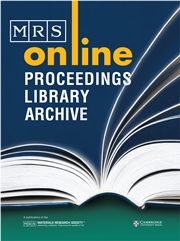Article contents
Thermomechanical Properties and Shape-Memory Capability of Drug Loaded Semi-Crystalline Polyestermethacrylate Networks
Published online by Cambridge University Press: 31 January 2011
Abstract
Polymer networks synthesized by UV-curing of Oligo[(ε-caprolactone)-co-glycolide]dimethacrylates are hydolytically degradable. Their architecture with covalent netpoints and crystallizable domains is the molecular basis for the potential shape-memory capability. The molecular weight and glycolide content of the oligomeric precursors can be varied over a broad range of compositions to tailor the thermomechanical properties of the polymer network while having only a minor influence on the shape-memory effect. Recently, drug incorporation adding controlled drug release as further functionality to the polymer network was demonstrated [4]. Here, enoxacin and ethacridine lactate as test drugs were incorporated into the networks by soaking. Alternatively, defined amounts of ethacridine lactate were mixed with the precursors, which were subsequently crosslinked to the drug containing networks. The composition of the oligomeric precursors in molecular weight between 3800 and 12800 g�mol-1 and in glycolide content ϝG between 0 and 30 mol-% to explore the influence of the drug incorporation on networks with varying compositions while retaining properties and functionalities. Polymer networks prepared from precursors with ϝG ? 14 mol-% and Mn ? 6900 g�mol-1 have a Tsw of 35-52 �C and sufficient crystallinity to ensure a high shape fixity in the programming step. These limits have to be kept to ensure the desired multifunctionality, otherwise drug incorporation can have an undesired influence on thermal, mechanical, and shape-memory properties.
Keywords
Information
- Type
- Research Article
- Information
- MRS Online Proceedings Library (OPL) , Volume 1190: Symposium NN – Active Polymers , 2009 , 1190-NN06-02
- Copyright
- Copyright © Materials Research Society 2009
References
- 7
- Cited by

